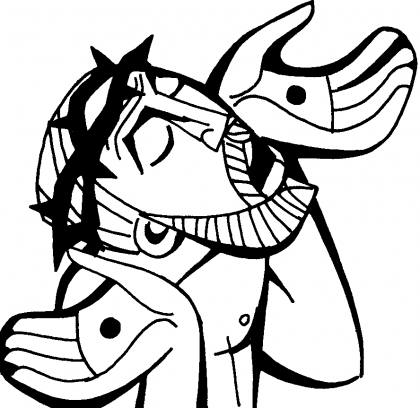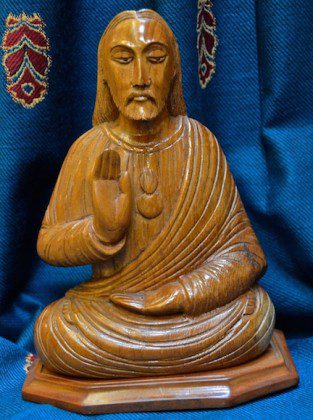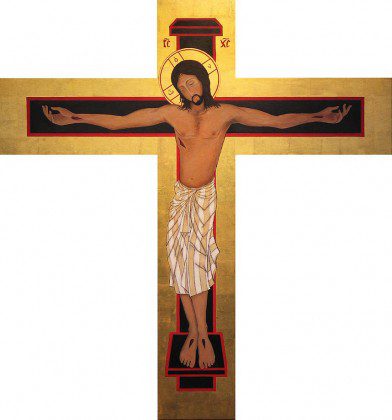“…take my soul into your most sacred wound, so that in this school of love, I may learn to make a return of love to God, who has given me such wondrous proofs of his love.”
Line 1
Each week David Schimmel, our province director of Dehonian Associates, will post reflections and prayers on the “Dehonian Spirituality” page of the website. See previous weeks’ reflections under the various headings on the left side of the Dehonian Spirituality page or use the drop-down menu at the top of this page under “Dehonian Spirituality.”
POSTED: April 11, 2014
 Leo Dehon spent six years pursuing seminary studies. His training included philosophy, in which he obtained a doctorate after his first year of study, and theology and canon law, in which he obtained doctorates during his final year of study. In between, the Franco Prussian War and Italy’s invasion of the Papal States postponed his education, while his work as a stenographer at Vatican I enriched it.
Leo Dehon spent six years pursuing seminary studies. His training included philosophy, in which he obtained a doctorate after his first year of study, and theology and canon law, in which he obtained doctorates during his final year of study. In between, the Franco Prussian War and Italy’s invasion of the Papal States postponed his education, while his work as a stenographer at Vatican I enriched it.
As successful as he was academically, Dehon gave prime importance to his spiritual development. Looking back on that time, he wrote, “Our Lord quickly took possession of my interior life and implanted therein certain habits that became the dominant rule of my life, despite my many failings: devotion to his Sacred Heart, humility, conformity to his will, union with him, a life of love. Such were the ideals that I tried to live all through my life.”
In his spiritual reading, he “noticed that the saints, like the members of the feudal nobility, generally had a motto that served to inspire them to spiritual combat. St. Ignatius had, ‘For the greater glory of God’ and St. Aloysius Gonzaga had, ‘What is this next to eternity?’ St. Theresa had, ‘One soul, one eternity’ and St. Francis Xavier had, ‘Conquer yourself.’ For myself, I adopted, ‘Lord, what do you want me to do?’ I could find nothing more suitable for solidifying and maintaining union with God.”
Particularly during his third year of study, a time that he considered the best period of his seminary life, Dehon responded with consistency to his chosen motto. “At every moment to do the will of God as best as I could know it” echoed throughout his diary. As he approached ordination he resolved, “not to concern myself about the future [but] to grow in sanctity now through fidelity to my rule. In the future, God will do with me what he wants. For the present God clearly asks me to be a perfect student.”
Yet, he was not without his dreams. Reflecting back on his seminary days, he wrote, “I often thought of dedicating myself to teaching, preaching, and social works. These were the leading ideas that presaged the ministry to which I was to devote myself later on.” He was careful, however, not to let his dreams obscure the grace of the present moment. “I should distrust the devil who, under the appearance of something good, distracts my prayer with thoughts of my future ministry or the vocation to a more perfect state. I should strive toward perfection in my current state.”
Keeping his attention firmly focused on his life in the seminary, he acknowledges, “The long range goal of our current work is the apostolate. God will determine the manner. The immediate goal is the sanctity of each day.” In summary, he writes, “Holiness consists in carrying out the simple actions of our state in life in union with God.”
 With too much to read, too little time to integrate new ideas, the pressure of getting good grades, and dreams of a satisfying future, students often contrast their life to “the real world.” Yet the real world is just as frantic, pressured, and populated with dreams deferred.
With too much to read, too little time to integrate new ideas, the pressure of getting good grades, and dreams of a satisfying future, students often contrast their life to “the real world.” Yet the real world is just as frantic, pressured, and populated with dreams deferred.
Indeed, the distinction between full-time studies and full-time employment is not so great when considered from the perspective of motivation, which directly affects action. Both students and workers can accomplish their tasks with a minimum of effort or with passion, with mediocrity or with excellence. Usually, a student’s motivation sets a pattern for the rest of his or her life.
The daily practice of oblation includes regular discernment of God’s will in each of life’s circumstances and the commitment to follow God’s will wholeheartedly. In the real world of academic pursuits, God desires individuals to be the best students that they can be. This deceptively simple expression of God’s will, however, requires much energy to remain consistently focused. Yet, with no need to compare oneself to other students or to compete with them, life is less frantic, less pressured, and less likely to defer the dream of a satisfying present.
 Images of the Heart of Jesus abound, but only a few seem to hold the attention of most Catholics. Yet, the variety of images proves helpful to those who understand that their spirituality is nourished, not only with affirmation, but also with challenge. If a picture is worth a thousand words, then unconventional images of the Heart of Jesus can serve to awaken a new consciousness, expand understanding, and deepen faith.
Images of the Heart of Jesus abound, but only a few seem to hold the attention of most Catholics. Yet, the variety of images proves helpful to those who understand that their spirituality is nourished, not only with affirmation, but also with challenge. If a picture is worth a thousand words, then unconventional images of the Heart of Jesus can serve to awaken a new consciousness, expand understanding, and deepen faith.
To a Westerner, it might seem strange to see an image of the Heart of Jesus in a meditative pose favored by the contemplative traditions of Hindus, Buddhists, and Jains. Yet, it’s possible that most Catholics in India, being in the religious minority, would be equally surprised to imagine Jesus looking different from the Western portrayals that are almost universal throughout Christianity.

In this image, Jesus is sitting in a cross-legged or lotus position, which supports meditation by encouraging proper breathing and bodily alignment. His eyes remain open, but focused downward. His left hand, resting on his lap, depicts a traditional gesture of meditation, while the open palm of his right hand, raised at chest level and facing outward, indicates fearlessness, spiritual power, and a blessing of deep inner peace. Jesus is simultaneously meditating and sharing the benefits of his prayer.
The pose is one of a guru or teacher, so highly revered in the culture of India. With a simple outline of the heart on his chest, this image calls to mind Jesus’ words to his disciples. “Come to me, all you that are weary and are carrying heavy burdens, and I will give you rest. Take my yoke upon you, and learn from me; for I am gentle and humble of heart, and you will find rest for your souls” [Mathew 11:28-29].
What does this image teach you about the connection between your prayer and your daily activities? What does this image suggest about religious expressions that are not your own? What specific expression of God’s love does this image of the Heart of Jesus suggest to you?
 In your kindness, throughout the coming week, please remember in your prayer the faculty, staff, Board of Directors, and students at Sacred Heart School of Theology, in Hales Corners, WI.
In your kindness, throughout the coming week, please remember in your prayer the faculty, staff, Board of Directors, and students at Sacred Heart School of Theology, in Hales Corners, WI.
Try to set aside some time each day for personal prayer. The amount of time is not as crucial as a regular habit of prayer. You might begin your time with the following prayer, which Fr. Leo Dehon composed to introduce his book of meditations, The Love of the Sacred Heart.
O my good Master,
as I come before you in reverent silence,
I will remain calm in your presence
like an expectant canvas.
I will peacefully and lovingly
contemplate the mysteries of your life.
I will be open to your grace and your love.
In this way
I will easily distance myself
from distracting thoughts
and I will purify my heart
in the fire of your love
that I may be attentive to your gentle voice,
which wants to offer me the gift of your heart.
Amen.


